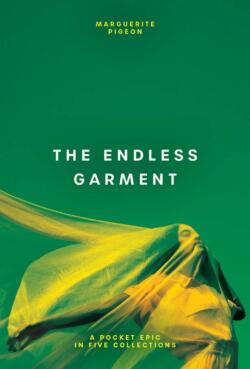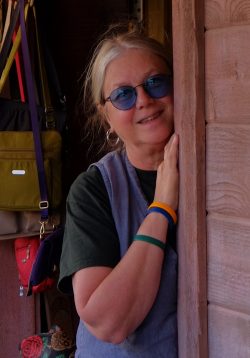1299 Cut from a cloth of desire
The Endless Garment
by Marguerite Pigeon
Hamilton, ON: Wolsak & Wynn, 2021
$18.00 / 9781989496374
Reviewed by Heidi Greco
*
 Admiration. That’s the feeling I get when I think of authors who are able to envision a big picture for their manuscript, who can write to a unified subject or theme. Poet Marguerite Pigeon is one such writer. To assert this, I go back to her first book, Inventory (Anvil, 2009), which was about various elements of everyday life, from people and places — poems there include even “Elastic Band” and “Held Breath.”
Admiration. That’s the feeling I get when I think of authors who are able to envision a big picture for their manuscript, who can write to a unified subject or theme. Poet Marguerite Pigeon is one such writer. To assert this, I go back to her first book, Inventory (Anvil, 2009), which was about various elements of everyday life, from people and places — poems there include even “Elastic Band” and “Held Breath.”
Her newest book, The Endless Garment, is an extended poem that places its focus on many aspects of fashion. And I suppose anyone who knows me might ask why someone generally as disheveled as I often am would comment on a book about fashion. Nonetheless, let me try.
Divided into sections invoking the seasons of the fashion world, she begins, aptly enough with “Pre-Season” a brief historical overview, setting us up for all that will follow, ending with this line, an invitation: “So chuck it all. Join me. Let’s shop.” Yet for anyone thinking that fashion as a theme might be frivolous, they need to think again, as Pigeon digs deep, going to source and beyond.
“Fall/Winter” opens with some autobiography, growing up, falling for the Vaselined images in magazines designed to tempt young women, moving from Sassy and Seventeen to “Sometimes Mademoiselle and Vogue.” Then, who do we meet but Coco Chanel, who likely did more to change women’s fashion than anyone before (or perhaps since).

A pinch of red lips over thin cig,
pending pearls on a bouclé knit,
patent-leather toe to gas and a top note of No5?
It can only be Mme. Chanel. (Achoo!)
Cheeky? You betcha. Not only a poet with style — and one who can comment on same — she’s got a sense of humour that sometimes peeks out like a flash of skin from a décolletage. And Chanel isn’t the only fashion icon in here; Pigeon gives us perfect thumbnail sketches of Grace Jones, Dolly Parton, Denise Huxtable, and Prince, then opens a door with a more detailed view of Lee McQueen who may well prove to be the star of the show.
And then it’s on through “Resort” and into “Spring/Summer” with its semi-horrific vision of existence in a Panopticon — a word I had to look up to be reminded of its full ramifications. Based on an invention from Jeremy Bentham in the 1780s, it’s a purpose-built building, a device for spying on unknowing subjects. The protagonist in this section, after viewing people from her own past, tries on various items of clothing and frequently invokes a voyeuristic sign as she too is being observed:
SEXY SEXY SEXY,
the neon insists.

While there, in that all-seeing/seen vision, among those she encounters is an early feminist who insisted on wearing pants:
Dr. Mary Edwards Walker the US Civil War
battlefield surgeon, dress reformer, lecturer
and pariah. I’ve read about the price she paid
for wearing pants to her 1850s wedding.
Was it worth it, Mary?
After more about Mary, our protagonist strips — baring not only flesh, but what might be considered as aspects of soul.
And then to “Diffusion” the closing section of this book-as-extended poem, in which she pulls back all layers of pretence, revealing some of the dirty secrets of fashion, from small children toiling away in faraway factories to disasters such as the Triangle Shirtwaist Factory fire, coming to a conclusion made meaningful for the reader who’s come this far.
More than historical narrative, these poems sing; their rhythms sometimes imitate an old-fashioned treadle-run sewing machine, its needle bobbing up and down through layers of hand-woven fabric. Read her words aloud. Listen.
Credit rearticulations by standing loom,
corsetry, touring actors, ambitious cocottes.
Credit the squinting envy of labour: mud
splatter on muscle, harmony in dungaree.
Credit trickle-down style: sobriety in cassock,
allure in criss-cross wraps pegged to Greek statuary.
Recurring sounds, echoing ideas. An Endless Garment, a recurring sound, unspooling as we follow its multilayered threads.
*

Heidi Greco lives and writes in a house in Surrey, BC, that’s surrounded by a mini-forest. Editor’s note: Heidi Greco has reviewed books by John Gould, Joanna Lilley, Laura Matwichuk, bill bissett, Patricia Young, and Sarah de Leeuw for The Ormsby Review. Three of her recent books have also been reviewed here: Glorious Birds: A Celebratory Homage to Harold and Maude (Anvil, 2021), reviewed by Linda Rogers; From the Heart of it All: Ten Years of Writing from Vancouver’s Downtown Eastside (Otter Press, 2018), reviewed by Yvonne Blomer; and Practical Anxiety (Inanna, 2018), reviewed by Andrew Parkin.
*
The Ormsby Review. More Books. More Reviews. More Often.
Publisher and Editor: Richard Mackie
The Ormsby Review is a journal service for in-depth coverage of BC books and authors in all fields and genres. The Advisory Board consists of Jean Barman, Wade Davis, Robin Fisher, Cole Harris, Hugh Johnston, Kathy Mezei, Patricia Roy, Maria Tippett, and Graeme Wynn. Scholarly Patron: SFU Graduate Liberal Studies. Honorary Patron: Yosef Wosk. Provincial Government Patron since September 2018: Creative BC
“Only connect.” – E.M. Forster
11 comments on “1299 Cut from a cloth of desire”